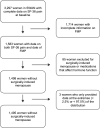Pain Severity in Relation to the Final Menstrual Period in a Prospective Multiethnic Observational Cohort: Results From the Study of Women's Health Across the Nation
- PMID: 27836812
- PMCID: PMC5291798
- DOI: 10.1016/j.jpain.2016.10.012
Pain Severity in Relation to the Final Menstrual Period in a Prospective Multiethnic Observational Cohort: Results From the Study of Women's Health Across the Nation
Abstract
The development of pain is common in midlife, resulting in increased health care utilization and costs. The aim of this study was to determine the longitudinal trajectory of overall bodily pain among women during the transition between the reproductive years and menopause. We conducted analyses on a community-based, longitudinal cohort of women enrolled in the Study of Women's Health Across the Nation. One thousand four hundred ninety-five women met inclusion criteria, including: 1) defined date of the final menstrual period (FMP), and 2) complete data on Short Form-36 bodily pain. The primary exposure was time to/from the FMP. The primary outcome was the rate of change in Short Form-36 bodily pain, measured on a scale of 0 to 100 with 100 being the most severe pain. We performed within-person trajectory analyses using piecewise regression following nonparametric modeling of functional forms. Mean bodily pain score at the time of the FMP was 29. Mean bodily pain increased at a rate of .26 per year during the transmenopause (the interval spanning 4.5 years before the FMP through .5 years after the FMP), and decreased at a rate of .23 per year after that. Depression and sleep problems were associated with greater increases in pain during the late reproductive years, whereas abdominal cramps at baseline predicted greater decreases in pain during the late reproductive years.
Perspective: This article shows that bodily pain increases during the transmenopause and then diminishes during postmenopause. These differences may reflect differences in underlying mechanisms of pain in the 2 periods. Although mean changes were small and unlikely to be clinically meaningful, the magnitude of change varied across subgroups of women.
Keywords: Pain; aging; female; menopause; perimenopause.
Copyright © 2016 American Pain Society. Published by Elsevier Inc. All rights reserved.
Figures


Similar articles
-
Bone mineral density loss in relation to the final menstrual period in a multiethnic cohort: results from the Study of Women's Health Across the Nation (SWAN).J Bone Miner Res. 2012 Jan;27(1):111-8. doi: 10.1002/jbmr.534. J Bone Miner Res. 2012. PMID: 21976317 Free PMC article.
-
Predicting the timeline to the final menstrual period: the study of women's health across the nation.J Clin Endocrinol Metab. 2013 Apr;98(4):1483-91. doi: 10.1210/jc.2012-3732. Epub 2013 Mar 26. J Clin Endocrinol Metab. 2013. PMID: 23533245 Free PMC article.
-
Helping midlife women predict the onset of the final menses: SWAN, the Study of Women's Health Across the Nation.Menopause. 2007 May-Jun;14(3 Pt 1):415-24. doi: 10.1097/gme.0b013e31802cc289. Menopause. 2007. PMID: 17303963
-
The menopausal transition--endocrinology.J Sex Med. 2008 Oct;5(10):2266-73. doi: 10.1111/j.1743-6109.2008.00921.x. Epub 2008 Jul 1. J Sex Med. 2008. PMID: 18624962 Review.
-
A review of menopause nomenclature.Reprod Health. 2022 Jan 31;19(1):29. doi: 10.1186/s12978-022-01336-7. Reprod Health. 2022. PMID: 35101087 Free PMC article. Review.
Cited by
-
Abdominal pain during the menopause transition and early postmenopause: observations from the Seattle Midlife Women's Health Study.Womens Midlife Health. 2019 Aug 2;5:2. doi: 10.1186/s40695-019-0046-5. eCollection 2019. Womens Midlife Health. 2019. PMID: 31388434 Free PMC article.
-
From maca to marijuana: cultural influences on joint pain symptoms and management in urban perimenopausal and early postmenopausal Latinas.Menopause. 2024 Sep 1;31(9):756-763. doi: 10.1097/GME.0000000000002396. Epub 2024 Jul 29. Menopause. 2024. PMID: 39078653 Free PMC article.
References
-
- Angst F, Aeschlimann A, Stucki G. Smallest detectable and minimal clinically important differences of rehabilitation intervention with their implications for required sample sizes using WOMAC and SF-36 quality of life measurement instruments in patients with osteoarthritis of the lower extremities. Arthritis Rheum. 2001;45:384–391. - PubMed
-
- Berecki-Gisolf J, Begum N, Dobson AJ. Symptoms reported by women in midlife: menopausal transition or aging? Menopause. 2009;16:1021–1029. - PubMed
-
- Comstock GW, Helsing KJ. Symptoms of depression in two communities. Psychol Med. 1976;6:551–563. - PubMed
Publication types
MeSH terms
Grants and funding
LinkOut - more resources
Full Text Sources
Other Literature Sources
Medical
Miscellaneous

